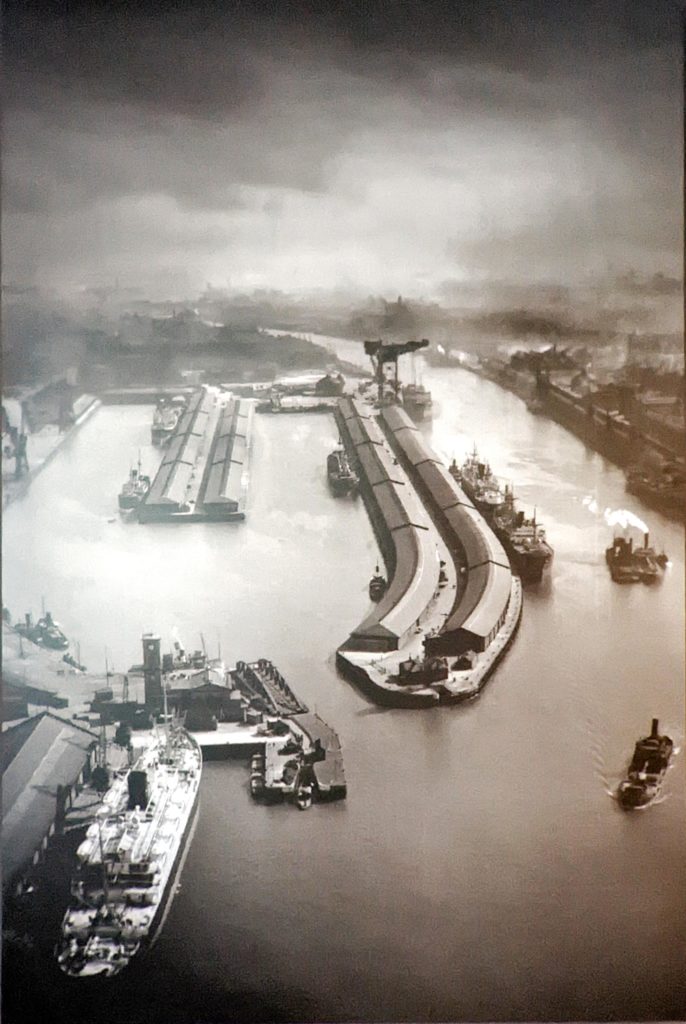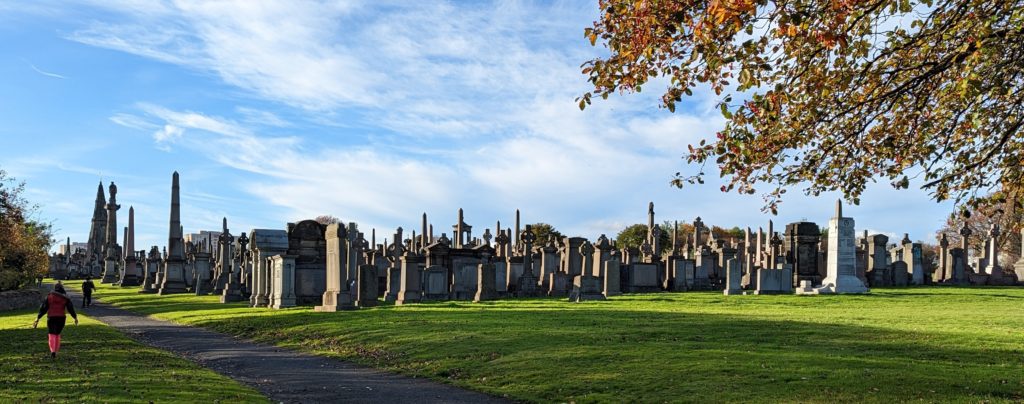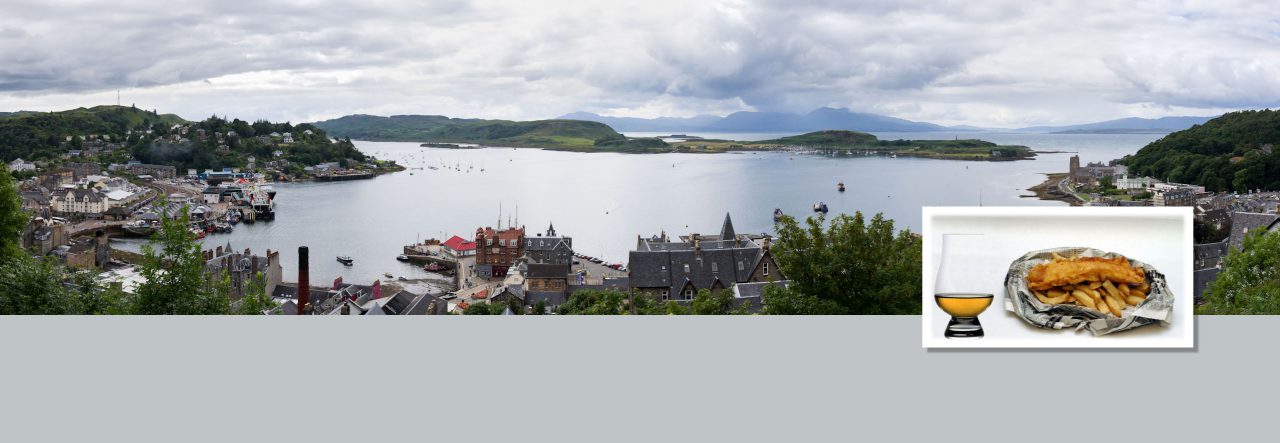In which I meet the good friend I’ll be travelling with, I meet a good old friend for lunch, I meet three new wondeful whiskies, and finally I meet an early and ancient grave…
Today is the first day of the rest of the trip. This trip to Scotland is really a two parter: time with the family, and time with whisky. Or, perhaps, time with members of my genetic family, and time with a member of my whisk(e)y family. Or something. Who cares. The imporant part is that, as of today, it’s whisky time.
John will be my travelling partner for the remainder of the trip. We met <cough> years ago, and have developed a mutual love for whisky over the years, cemented during our first Chicago WhiskyFest in 2013 (which we attended with Mike, another member of the whisk(e)y family). (I have to find a faster way to type whisk(e)y – those parens are a pain in the keyboard). John and I are well and truly (over)indulging our inner whisky geeks and outer whisky loving selves in a way that we would neither want to subject our families to, nor would likely be allowed to subject them to. In short, many distillery visits, much whisky tasting, and more driving to accomplish said than is considered reasonable in Scotland.

Less than an hour after we met up we got whisky things started with a tour of The Clydeside Distillery. Clydeside is located right on the side of the Clyde – I mean, it’s kinda right there in the name – and is a realtively new distillery. When it opened in 2017, it was the first new distillery in Glasgow in over a century. So it was about bloody time. It’s located inside the Pumphouse Building, at the west end of what used to be the Queen’s Dock. This building used to house the equipment that would open and close the bridge gate entry to the docks, as well as the ever popular Customs & Excise folks, who paid particular attention to the goods coming and going including the ever popular whisky. The idea behind the gate is that it prevented ships leaving without paying their dues, as well as keeping boats that were docked nice and secure. Well, one out of two isnae bad. Turns out blokes wi’ wee rowing boats or rubber dingys or whatever were slipping under the gate at night and helping themselves. But, have no fear, the tax men were on their game and put a swift end to that nonsense… about twenty years later.
The Clydeside Distillery is owned by Tim Morrison, which is particularly fitting as the Pumphouse was built by his great grandfather, John Morrison, back in 1863. Fun fact: Tim didn’t know this at the time. I mean he didn’t know when he bought it. Obviously he didn’t know about it when his great grandfather built it as his parents weren’t even twinkles in anybody’s eyes at that time. Great grandfather also had a hand in the development of Loch Katrine, which supplies water to the whole of Glasgow, including the new Clydeside Distillery. I believe that there are other whisky connections throughout the family line, but if you want to learn more about those, go find out for yourselves!
(In the interests of full disclosure, I should note that the last use of the Pumphouse before it became Clydeside was as a Karaoke Bar and Curry House. While I love me a good curry, I’m delighted to say that there are no traces of the related spices in the Clydeside whisky range).
Our guide for the day was Marcos, and it turned out that we had our own private tour. The 1000 and 1200 tours were busy, but the 1100 tour was just us two and Marcos, who subsequently became quite comfortable with his two very keen participants and let rip a few items that I’m very sure are not on the regular tour. (Ask me about the effects of drinking too much wash some time, in Marcos’ words…)
The tour starts with a wee video, where a couple of actors in period costume tell us a bit of the history of the Queen’s Dock and Pumphouse. It’s nicely done. Then you pop upstairs (past a great view up the Clyde of the Finneston Crane and SEC Armadillo), and into a small exhibit that talks about the five whisky barons of Glasgow: James Buchanan, Tommy Dewar, Peter Mackie, William Teacher, and Thomas Harvey. I’d tell you more about them, but I think it’s better that you take the tour. They summarize it nicely and I’d only get it wrong. There’s another room that talks about the Morrisons, but we sortof skipped that, because we were enjoying the Barons too much. Marcos came and got us for the next part of the tour: the workings of the distillery.
If you’ve read my other distillery tour ramblings, you’ll know that all single malt Scotch whisky is made essentially the same way: fresh barley becomes malted barley which becomes dried malted barley which becomes grist which, when bathed in water three times becomes wort which, after spending some quality time with yeast, becomes wash which is distilled to become low wines which is distilled to become new make spirit which is aged in barrels for three years and one day to become single malt Scotch whisky. The variations in flavor come from types of barley, how the barley is dried, how the wort is extracted, what yeast is used, how long the wort ferments to become wash, how long the wash is distilled, how long the low wines are distilled, the temperatures used in distilling, the method of heating used in distilling, the shape of the stills, the angle of the lyne arms, the types of condenser, the distillate cut that becomes new make, the barrels that are used to age it, the climate of the location where it’s aged, and some other pieces of magic.
It’s these details that make each tour interesting, even though we could recite the process by heart. At Clydeside, for example, they use 1.5 tons of grist to make their wort; they have 8 mash tuns at 7,500 liters each (which is pretty small); they have a slower distillation rate than Glengoyne (which proudly advertises the slowest distillation in Scotland.. until apparently 5 years ago). Another fun fact about Clydeside is that, due to a general lack of cattle in the Glasgow city center, they can’t practically use their draff (the discarded barley remnants following the wort production) as cattle feed. Instead, they sell it to a local biofuel company, where it generates enough power for about 100 houses every year. Which is kinda cool.
I just realized that I completely forgot to ask what kind of mill they used to grind the barley into grist. Must find that out. It’s a thing; you’ll likely learn more later on this trip.
Other details that we picked up today:
- Wort is highly laxative; offer a glass to someone you don’t like and enjoy the show.
- Wash is very sensitive to local temperature fluctuations, so fermentation time has to take that into account.
- The Scottish angel’s share amounts to about 25 million bottles of whisky lost to angels every year.
The tour ended with three samples. Well, four actually. OK, five, but only because we engaged Marcos as fellow whisky enthusiasts.
The regular tour tasting starts with their New Make Spirit, which is phenomenal. It’s so damned drinkable by itself (cut down fron 71% to 63% for consumption). They sell it in 200 ml bottles because early visitors to the distillery, before their product had aged enough to be legally called whisky, all told them that they should bottle and sell it. When your product has a minimum 3 year (and one day) lead time, anything your potential customers want to purchase from you that will make you some money in the mean time is A Good Thing(tm). So they sell it. It makes a mean G&T, where G is really NMS. The nose is sweet, with hints of the barley and mash. The taste is almost sweetcorn, which makes no sense but is wonderful.
Then we moved on to their 3 year and 8 month Bourbon Barrel aged whisky, which is silly smooth for something that young. Notes of Orkney Caramels, sweet malted barley, honey, and more.
Last of the regular tasting is their identically aged Sherry Cask, using oloroso sherry. This is all fruit loaf / xmas cake and fireplaces. The mouthfeel is wonderful.
Sadly, neither of these are available to purchase by themselves – they want to age them some more. But, they’ve taken some of each and mixed them to make their first release for sale, the Stobcross, which Marcos let us try in the shop. He also let us try their COP26 limited release, 1,700 bottles, distillery sales only. This is their whisky aged for a similar length of time, but using ex-bourbon quarter casks. The damned stuff looked like a sherry bomb. And tasted amazing. There may or may not be a bottle we’re splitting in a suitcase. I mean, we’ll split it outside the suitcase…
—————–
Following the tour, we headed off to meet a friend for lunch. Martin is my longest friend at this point… literally and figuratively: 6’5″, and someone I met 40 years ago. I could write an entire article… um, book, on our friendship and his shenanigans and mine, but I won’t. I will say, however, that like all good, long standing friends, we dropped right back into things as if we’d just seen each other last week. It’s been about four years (which sucks, and I hope doesn’t happen again).
Martin was kind enough to make us lunch (shakshous), and conversation ran the gamut. We finished by spending some time on Stable Diffusion, testing it’s ability to make images. That’s another article. But if you want to play, hit the site below, enter a ridiculous text description of an image, and sit back and watch it play. For more info on the AI behind it, visit [a secure t that I will add later].

We left Martin after a couple of hours for a date with the dead. John and I had both wanted to go visit the Glasgow Necropolis, so we did. I mean, fundamentally, it’s just a giant graveyard, but the place is magnificent. It lays claim to, I believe, about 50,000 souls, all of whom have probably the best view of the city, guarded by Glasgow Cathedral (and, more recently, The Batman, but that’s not really an official part of the deal).

A fascinating place to visit, a fascinating concept as a “tourist attraction”, and crazy that I’d never been there before.
The end of the day was dinner with the folks, who’ve met John a few times before and were looking forward to a visit. For local folks, I can highly recommend Garvies in Millgavie. Formerly the Cross Keys pub, I continue my record of never actually having set foot inside a Milngavie pub until years after it stopped being a pub and became a restaurant instead. <shrug>
Dropped John back in the city where I’ll collect him tomorrow, when we’ll disappear off up into the islands and highlands, in that order, for the next 10 days or so.
